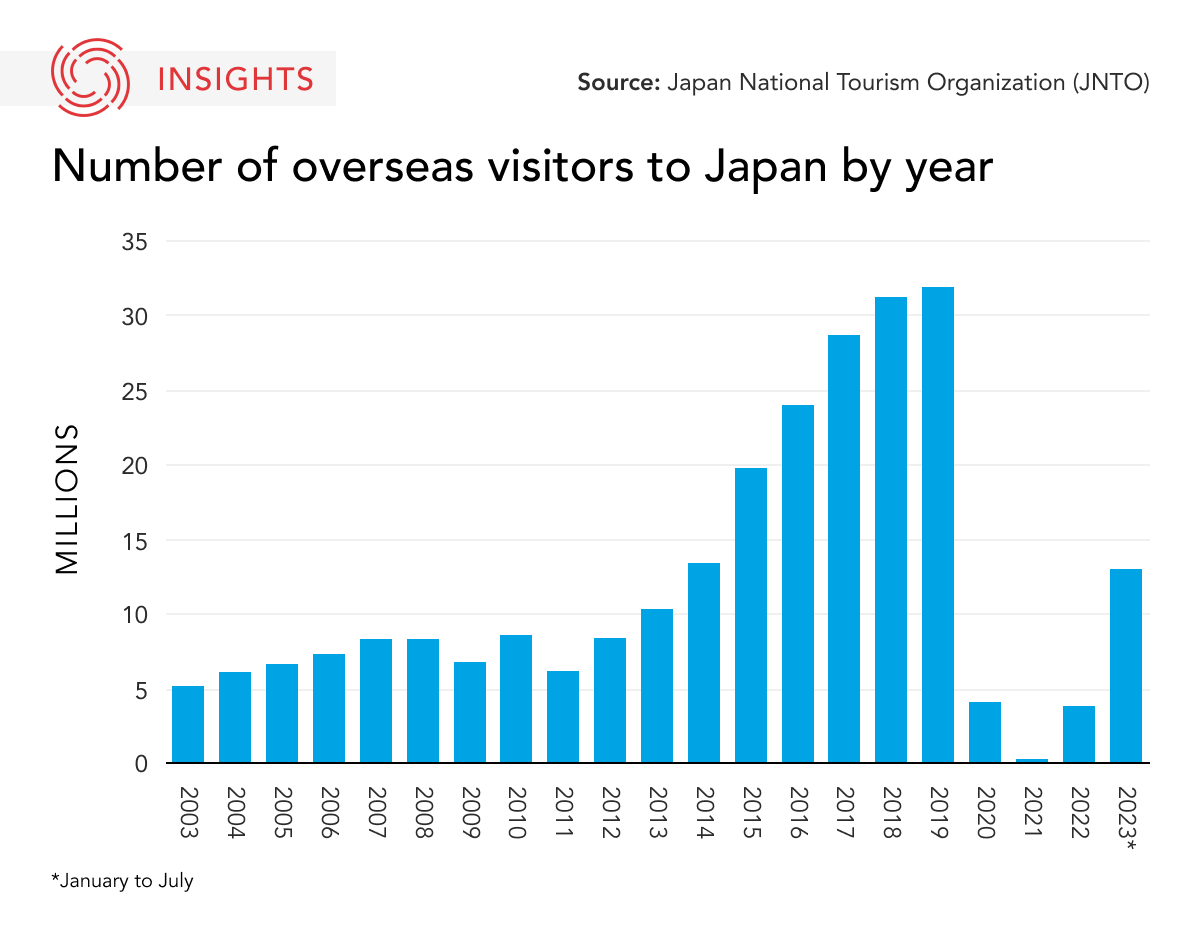The Takeaway
As a highly sought-after international tourist destination, Japan is currently experiencing a rebound in tourism, spurred by the country’s relaxation of COVID-19-related measures and the weak Japanese yen. However, the surge in visitors has reinvigorated debate about the shortcomings and challenges in Japan’s tourism industry, which must be addressed to create a sustainable and equitable industry.
In Brief
-
Since 2012, Japan has seen a significant increase in tourism, coinciding with late prime minister Abe Shinzo’s policy shift towards making Japan a “tourism-oriented country.” Despite the decline from 2020 to 2022, 2023 marked a year of recovery for Japan’s tourism industry, largely due to the country’s slow move towards a post-pandemic society.
- In March, Japan eased its mask-wearing guidelines, and in May, further downgraded the legal status of COVID-19 to the classification of a “common infectious disease,” similar to a seasonal flu. With the Japanese yen’s historic depreciation, travel blogs and social media influencers are echoing the same phrase: now is the time to visit Japan.

- While many businesses and governments are welcoming tourism as a means to boost revenue and GDP, the rebound of visitors has highlighted several challenges within the tourism industry amid evolving travel preferences from group tours to more individualized travel.
- In June, the Japan Tourism Agency’s annual tourism white paper called for the transformation of tourism in Japan to make the industry more profitable while addressing structural problems such as low wages, overwork, labour shortages, and an aging workforce. And in August, Japanese Prime Minister Kishida Fumio announced that the government is actively formulating measures to address the negative effects of ‘overtourism,’ all while increasing tourist numbers and revenue.
Implications
In 2019, Japan’s tourism industry was the third-largest in the world, contributing a record high of C$491.5 billion to the country’s C$6.97-trillion GDP. Given such figures, the Japanese government has identified tourism as a critical area for Japan’s post-COVID-19 economic recovery.
For many businesses and rural municipalities, the magnitude of Japan’s tourism industry offers myriad revitalization opportunities to their communities. In September, Japanese lifestyle brand MUJI launched a new program to turn abandoned Japanese-style homes in rural Japan into vacation rental properties. Additionally, municipalities in Gunma Prefecture have begun testing vacation packages and offering direct bus services from Haneda Airport to the prefecture to attract more tourists. But so far, Gunma’s vacation packages have received no bookings, further highlighting just how difficult it is to attract tourists beyond popular tourist sites.
Much of Japan’s tourism is concentrated in urban or world-famous areas such as Tokyo, Kyoto, or Mount Fuji. Many of these areas are faced with problems of increased petty crime, waste management, noise pollution, and overcrowding, which can negatively affect the environment and disrupt the lives of residents. Overtourism may present genuine safety risks for both residents and tourists, sometimes with fatal consequences.
Tourism will likely return to 2019 levels and surge past it in the years to come. And while it is an essential activity for many Japanese regions, its negative effects must also be mitigated to create a sustainable and equitable industry.
What's Next
- Using technology to boost tourism
In July, Tokyo’s Seibu Railway began testing a new real-time translation device to better facilitate communication with the growing number of international visitors. Similarly, in October, Japan Railways Kyushu test-launched an artificial intelligence-powered station attendant that can communicate with tourists in several languages. Such new technologies to manage international visitors are expected to increase throughout Japan.
- Further innovation to draw visitors
In April, Shirakawa City opened the doors to a new tourist information centre with a popular ramen database and Fukuoka City launched a multilingual tourism website to attract visitors in May. Rural municipalities can draw from existing initiatives to devise innovative incentives, attracting both international and domestic tourists.
- Everything in moderation
To mitigate the negative effects of overtourism, popular tourist locations like Miyajima — a small island close to Hiroshima — have begun implementing measures such as visitors’ taxes. Similarly, Yamanashi Prefecture has proposed creating a new light rail system to reduce car usage near Mount Fuji. Other popular destinations will undoubtedly develop measures that will increasingly focus on improving the quality of tourism in Japan. The national government’s measures against overtourism are expected to be announced this fall.
• Produced by CAST’s Northeast Asia team: Dr. Scott Harrison (Senior Program Manager); Momo Sakudo (Analyst); and Tae Yeon Eom (Analyst).




